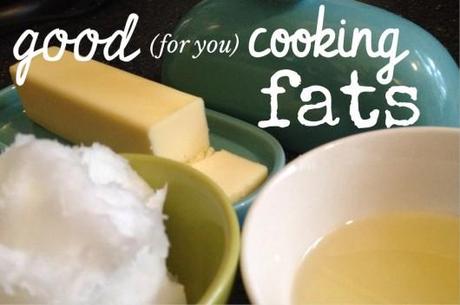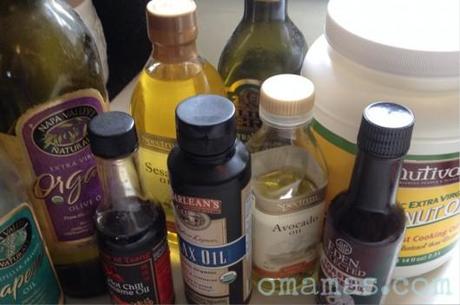Before you spritz that vegetable cooking spray in your pan …
WAIT!
Put the vegetable oil down and step away from the stove!
Seriously.
If you’re still cooking with vegetable or canola oil, I want you to consider that canola oil is only five percent saturated fat (WHICH IS NOT A GOOD THING). The process to extract the oil from the rape seed requires high heat, hydrogen, solvents, bleach, deodorant, etc, to make it palatable. It has a high sulphur content, and goes rancid quickly and easily, which makes it difficult for our bodies to digest.
Thankfully, there are finally reports reaching the mainstream that are showing what Weston A. Price knew in the 1930s when he was doing his research on the benefits of traditional diets. Saturated fats are not the enemy.
The news is out: Saturated Fats are not bad for you.

I know a lot of people who live in fear of fat.
They cook with teflon or add a squirt of cooking spray to the bottom of the pan. Butter their bread with margarine. Drink low fat milk. Eat non-fat yogurt. And they do it on the order of their heart-conscious doctor.
I’m not going to tell you to ignore the advice of your medical professional. I’m not a doctor, after all.
But I’m going to ask you ton consider that you share this article with him/her. Ask about the new research. Engage him/her in a conversation to understand where the recommendations come from.
In her book Nourishing Traditions, Sally Fallon, PhD, shares pages and pages of evidence refuting what she calls the “Diet Dictocrats” with studies from all over the world that suggest we need fat. She states simply “Fats from animal and vegetable sources provide a concentrated source of energy in the diet; they also provide the building blocks for cell membranes and a variety of hormones and hormone-like substances. Fats as part of a meal slow down nutrient absorption so that we can go longer without feeling hungry. In addition, they act as carriers for important fat-soluble vitamins A, D, E and K. Dietary fats are needed for the conversion of carotene to vitamin A, for mineral absorption and for a host of other processes.”
It may not change your world.
It certainly may not change the mind of your doctor.
The evidence hasn’t yet swayed The American Heart Association, but the evidence is clear. And it’s worth a conversation, at least.
So now what?
What fats belong in your cupboard?

COOKING FATS
Some fats are good for cooking. They have a high smoke-point and retain their nutrient dense composition at high heat. They help us absorb nutrients from high protein foods. And they have a stable shelf life. These are the primary cooking oils/fats that we use in our kitchen:
- Avocado oil – Nutritionally, avocado oil is right up there with olive oil boasting serious amounts of monounsaturated and polyunsaturated fatty acids. It’s also a good source of complex proteins, lecithin, beta-carotne and vitamins A, D and E. But unlike olive oil, the mighty avocado oil has a really high smoke point (500 degrees), a stable shelf life and a very subtle aromatic flavor.
- Butter – raw, organic, pastured, locally sourced butter is your best bet, as it’s not going to be quite so nutrient dense from cows eating a primarily grain-fed diet. We love Kerrygold Irish Butter because it is grassfed, the only ingredients are cream and salt, and there are no artificial colors. When we’ve got raw milk from our local herd-share, I’ve even been known to make my own.
- Coconut Oil – unrefined, cold pressed, organic, coconut oil is a great source of lauric acid and has antibacterial, anti-fungal and anti-microbial attributes. It’s also so readily available these days. We use coconut oil a lot. In baked goods. For frying. For popping popcorn. In smoothies. In French Toast. We use it topically (on minor abrasions and sunburn). We just love the Coconut Oil.
- Chicken, Duck, Goose fat – choose duck or goose over chicken for more omega-6 and omega-3 fatty acids. And look for a reputable source. I’m going to admit that we only use chicken, duck and goose fat on rare occasion. I’ve not found a reasonable and reliable local source for it.
- Lard – If you can find a healthy source of lard (from sustainably, pasture-raised pigs), lard is stable and good for frying and is an excellent source of vitamin D. I love fresh homemade tortillas … and the difference between ones made with lard versus ones made with vegetable shortening is UNREAL. It’s worth a little homework to find good lard.
- Beef & Mutton Tallows – The Weston A. Price Foundation recommends use of beef and mutton tallows, but I’ll admit it … I’ve never tried them. If you do, can you let me know how it goes?
- Peanut & Sesame Oil – good for occasional stir fries, but contains a high percentage of oleic acid, so both should be used sparingly.
EAT RAW (never heat)
These good-for-you oils are staples in our diet. We use them in salad dressings and smoothies, but never in the skillet as heating them destroys their nutrient dense composition and makes them really difficult for your gut to process.
- Olive Oil – extra virgin, cold pressed is the way to go. We’ve been reading a lot about how finding “pure” olive oil can be a challenge these days as some of the biggest purveyors in the US have been found to have unwittingly been importing olive oil adulterated with soy and vegetable oils. Ugh. So, take some care to make sure when you buy Olive Oil you are getting Olive Oil!
- Unrefined Flaxseed Oil – Extremely high omega-3 content!! So good for you. But keep it refrigerated!
- Grape Seed Oil – We use this primarily because of it’s similarity to Olive Oil. And it’s got a smooth buttery taste. We’ve used it often to make our own mayonnaise, but the green color can be a bit of a turn-off.
- Nut Oils like Walnut and Macadamia - Both are so tasty, but very expensive, so we use these sparingly in salad dressing. Walnut oil has to be stored in a cool dry place to avoid oxidization.
- Red Palm Oil - similar to Coconut Oil in that it’s one of the few available vegetable saturated fats. There is some controversy about the palm oil industry, so we don’t often choose this oil. But from a traditional food perspective, this is a vegetable oil that has been utilized for more than 5,000 years.
- Sunflower Oil - choose cold pressed sunflower oil to preserve Vitamin E and eliminate free radicals produced during other production methods. But keep in mind that it doesn’t contain the good Omega-3 fats. We primarily use this in our homemade mayonnaise these days because it’s nearly flavorless and it’s not “green” like Grape Seed Oil.
RANCID OILS/FATS TO AVOID LIKE THE PLAGUE
In the “good ol’ days” oils were extracted using cold pressed or expeller pressed methods that retained the integrity of the “food” in our food. I don’t want to seem old fashioned. But my personal problem with fats like Canola, Margarine, Shortening, etc, is that the process to make them is so volatile (involving solvents and bleaches and deodorizers) that what’s left for consumption has little resemblance to food. If it has to be deodorized because it smells rancid and unpalatable, chances are, it’s rancid and unpalatable. And I don’t need a chemist to trick my body into eating something it shouldn’t.
That said, these are the fats and oils that we’ve scrubbed from our kitchen:
- Canola Oil – has a high sulphur content and is typically rancid because of the high heat used in the extraction process. There are studies now showing that canola oil can contribute to a vitamin E deficiency (which we need for a healthy heart).
- Corn Oil – on it’s own, corn oil might not be awful, but since more than 85 percent of the corn on the US market is GMO corn and contains high levels of the pesticide glyphosate, it’s hard to find pure organic corn oil and we avoid it.
- Cottonseed Oil – first of all, it’s made from the inedible cotton plant. Secondly, it’s near-impossible to come by a non-GMO cottonseed oil because it’s one of the big-4 Monsanto GMO crops. It’s everywhere (margarine, shortening, box cereals, processed cookies, crackers, et al). But it doesn’t belong in the cupboard.
- Margarine & Vegetable Shortening - the process to make margarine and shortening is called hydrogenation. It goes something like this: Cheap oils (like soy, corn, cottonseed or canola) are mixed with a catalyst (tiny metal particles like nickel oxide) and then pressurized with hydrogen gas to turn the oil into a solid at room temperature. Then emulsifiers are added to correct the texture. It then has to be “deodorized” by “steam cleaning” at extremely high temperatures and bleached to eliminate it’s unnatural grey color. And finally, to make margarine, food coloring and flavors must be added to make it taste more like butter.
- Soybean oil - like Corn Oil, it’s so challenging to find organic soybean oil. And despite the high levels of Omega-6 and Omega-3 fatty acids, I’ve read too often that soy is an endocrine disruptor that we avoid also soybean oil.
- Vegetable oil - the conventional factory process to make vegetable oil involves overheating the crushed seeds, washing them with toxic solvents to extract every last bit of oil, destroying healthy antioxidants in the seeds and resulting oil just isn’t something I want to feed my family.
So now it’s time to clean the cupboard …
… and use more butter.
xo,
Jeanne
Q: What healthy fats do you use and how do you add them to your diet?
